Blog, Industry News, trenchless projects
Ceremony with Georgian Prime Minister commissions Green Power Station
 In April 2017, a ceremony was held to celebrate the commissioning of the Dariali Hydropower Project in the Republic of Georgia. Many attended the ceremony marking the first carbon-neutral hydropower project in the world, including Georgian Prime Minister, Giorgi Kvirikashvili. The power station, an independent power project (IPP) developed through Dariali Energy Ltd, was a joint venture involving three other firms: Georgian private companies Peri Ltd and Energy LLC, and state-owned Georgian Energy Development Fund (GEDF). The Dariali HPP gathers water from the Tergi River and directs it through the headrace tunnel to the power house located near the Russian—Georgian border. Each year, the site will generate 500 GWhs of carbon-neutral energy, with 70 percent of power production occurring during the country’s summer months.
In April 2017, a ceremony was held to celebrate the commissioning of the Dariali Hydropower Project in the Republic of Georgia. Many attended the ceremony marking the first carbon-neutral hydropower project in the world, including Georgian Prime Minister, Giorgi Kvirikashvili. The power station, an independent power project (IPP) developed through Dariali Energy Ltd, was a joint venture involving three other firms: Georgian private companies Peri Ltd and Energy LLC, and state-owned Georgian Energy Development Fund (GEDF). The Dariali HPP gathers water from the Tergi River and directs it through the headrace tunnel to the power house located near the Russian—Georgian border. Each year, the site will generate 500 GWhs of carbon-neutral energy, with 70 percent of power production occurring during the country’s summer months.
Robbins also invested in the project by gaining equity through supplying tunneling equipment and services in consortium with contractor Peri. “Robbins understood the risk in the tunneling portion of the project and we were compensated for taking on part of the risk. Peri is a long-time customer, as we supplied a TBM to them 15 years ago for a small project in Georgia. It was great to be invited to invest and risk share on this project, and to work together again,” said Robbins President Lok Home. The 5 km (3 mi) long headrace tunnel for the power station was bored with the use of a 5.5 m (18 ft) diameter Robbins Main Beam TBM starting in February 2012.
 Due to the remote and mountainous location of the jobsite 160 km (100 mi) from the capital Tbilisi, the machine was shipped in pieces to contractor Peri’s workshop, where they were refurbished under Robbins supervision and then delivered to the site to be assembled. Each piece was transported by truck down narrow, winding roads that eventually gave way to dirt paths. Assembly at the jobsite was difficult, as the project site at a 1,700 m (1.0 mi) altitude was blanketed in snow and components arrived in December. Bone-chilling temperatures often reached negative 15 degrees Celsius (5ºF), and 40 below with the wind chill factor. Once the machine had launched, it encountered difficult ground including slate, sandstone, limestone and malms with fault zones.
Due to the remote and mountainous location of the jobsite 160 km (100 mi) from the capital Tbilisi, the machine was shipped in pieces to contractor Peri’s workshop, where they were refurbished under Robbins supervision and then delivered to the site to be assembled. Each piece was transported by truck down narrow, winding roads that eventually gave way to dirt paths. Assembly at the jobsite was difficult, as the project site at a 1,700 m (1.0 mi) altitude was blanketed in snow and components arrived in December. Bone-chilling temperatures often reached negative 15 degrees Celsius (5ºF), and 40 below with the wind chill factor. Once the machine had launched, it encountered difficult ground including slate, sandstone, limestone and malms with fault zones.
“The main challenges we faced were boring the tunnel at a 6 percent incline and having restricted access to service the machine. There were also two major landslides that delayed the project for over a year,” said Home. After the first landslide, the access tunnel, which had allowed mud and water to enter the power station, had to be relocated at a higher elevation and facing away from the river valley. When the machine was nearing the end of its bore, a second landslide blocked the exit portal for the machine as well as access to the main highway. Despite these challenges, tunneling crews persevered and the machine successfully holed through in October 2014.
Throughout the construction process, careful steps were taken to minimize the carbon footprint. Although the plant’s energy production is carbon emission free, construction of the plant was not. To offset these emissions, 7,000 seedlings are being planted all around the area in a reforestation effort. In years to come, the trees will absorb enough carbon dioxide to compensate for the emissions produced during the construction of the hydropower plant.
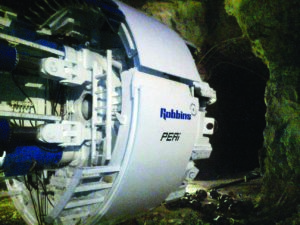 Overall, said Home, there is much to celebrate as the project has immense benefits: “Not only does it provide affordable electrical power for the country with essentially no pollution effects, but it also provided jobs during construction and will continue providing jobs during its operation and maintenance.”
Overall, said Home, there is much to celebrate as the project has immense benefits: “Not only does it provide affordable electrical power for the country with essentially no pollution effects, but it also provided jobs during construction and will continue providing jobs during its operation and maintenance.”
Image 1: Georgian Prime Minister Giorgi Kvirikashvili marked the startup of the world’s first carbon-neutral hydropower project.
Image 2: In April 2017, the Dariali HPP became operational in the Republic of Georgia.
Image 3: Robbins supplied a 5.5 m (18 ft) diameter Main Beam TBM to bore the 5 km (3 mi) headrace tunnel.
Blog, Industry News, trenchless projects
Rebuilt TBM Will Bore in La Ciotat, France to Improve Access to Water Supply
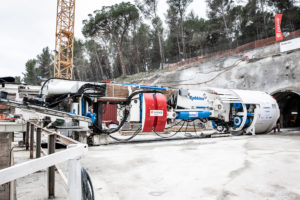 A Robbins TBM, recently christened “Augustine”, is being commissioned to undertake its eighth bore after being launched by contractor Eiffage Civil Engineering on March 3. The TBM, which was extensively modernized and upgraded during the rebuild for the Galerie des Janots project in La Ciotat, France, has previously completed seven other successful projects across Europe and Hong Kong. This time, it will bore the Janots gallery to improve access to water in the communities east of the Aix-Marseille-Provence metropolis (Cassis, Roquefort-la-Bédoule, La Ciotat and Ceyreste). “It’s a single machine 3.5 meters (11.5 ft) in diameter, 250 metric tons (275 US tons), and 135 meters (443 ft) long, that will work 24 hours a day for almost 10 months during this operation,” says Marc Dhiersat, Project Director of Galerie des Janots for Eiffage.
A Robbins TBM, recently christened “Augustine”, is being commissioned to undertake its eighth bore after being launched by contractor Eiffage Civil Engineering on March 3. The TBM, which was extensively modernized and upgraded during the rebuild for the Galerie des Janots project in La Ciotat, France, has previously completed seven other successful projects across Europe and Hong Kong. This time, it will bore the Janots gallery to improve access to water in the communities east of the Aix-Marseille-Provence metropolis (Cassis, Roquefort-la-Bédoule, La Ciotat and Ceyreste). “It’s a single machine 3.5 meters (11.5 ft) in diameter, 250 metric tons (275 US tons), and 135 meters (443 ft) long, that will work 24 hours a day for almost 10 months during this operation,” says Marc Dhiersat, Project Director of Galerie des Janots for Eiffage.
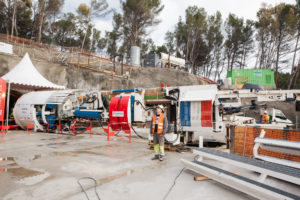 Currently, the machine is ramping up as back-up decks are being installed. As of April 2017, the machine has bored more than 51 m (167 ft), mainly encountering limestone. “Limestone is a rock easy to dig, but one can be confronted with the phenomenon of karst,” explains Loïc Thévenot, Director of Underground Works for Eiffage. “For this purpose, the tunnel boring machine is equipped with a probe drill. If the karst is small, we will fill it with concrete. If it is large, we will erect a small parallel gallery.”
Currently, the machine is ramping up as back-up decks are being installed. As of April 2017, the machine has bored more than 51 m (167 ft), mainly encountering limestone. “Limestone is a rock easy to dig, but one can be confronted with the phenomenon of karst,” explains Loïc Thévenot, Director of Underground Works for Eiffage. “For this purpose, the tunnel boring machine is equipped with a probe drill. If the karst is small, we will fill it with concrete. If it is large, we will erect a small parallel gallery.”
Galerie des Janots is one of the fourteen operations designed to save water and protect resources, which are being carried out by the Aix-Marseille-Provence metropolis, water agency Rhône Mediterranean Corsica, and the State Government. The future Janots gallery will replace existing pipelines currently located in the railway tunnel that have significant safety and vulnerability deficiencies with estimated water losses of 500,000 cubic meters (132 million gallons) per year. According to Danielle Milon, Mayor of Cassis, “This is an investment of 55 million euros (USD $59 million) with 11 million in aid from the water agency. This project required 10 years of reflection and work to improve water supply. And water is essential for the development of each municipality, and for citizens’ well-being.”
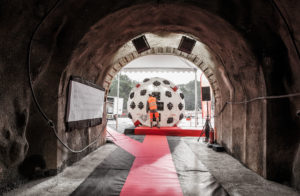 Augustine is boring a tunnel 2,750 m (1.7 mi) long, and will pass under Le Parc National des Calanques, with cover between 15 and 180 meters (50 to 600 ft), in order to replace the pipes that are currently being utilized for the water supply networks. “[The current pipes] have a capacity of transit limited to 330 liters (87 gallons) per second, which is largely insufficient in the summer period. The objective of the operation is to increase to 440 liters (116 gallons) per second,” says Dhiersat. Once the project is complete, networks can easily be maintained in comparison to the old pipes currently running beneath the railway.
Augustine is boring a tunnel 2,750 m (1.7 mi) long, and will pass under Le Parc National des Calanques, with cover between 15 and 180 meters (50 to 600 ft), in order to replace the pipes that are currently being utilized for the water supply networks. “[The current pipes] have a capacity of transit limited to 330 liters (87 gallons) per second, which is largely insufficient in the summer period. The objective of the operation is to increase to 440 liters (116 gallons) per second,” says Dhiersat. Once the project is complete, networks can easily be maintained in comparison to the old pipes currently running beneath the railway.
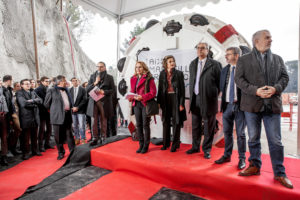 Image 1: The 3.5 m (11.5 ft) diameter Robbins Main Beam TBM is boring its eighth tunnel in La Ciotat, France.
Image 1: The 3.5 m (11.5 ft) diameter Robbins Main Beam TBM is boring its eighth tunnel in La Ciotat, France.
Image 2: The Robbins TBM is excavating limestone rock with possible karst cavities for the 2.75 km (1.70 mi) Galerie des Janots Project.
Image 3: Contractor Eiffage Civil Engineering is operating the Robbins TBM, which is ramping up production having bored more than 51 m (167 ft) since March.
Image 4: The Galerie des Janots project will upgrade currently overtaxed water supply lines serving several communities east of France’s Aix-Marseille-Provence metropolis.
Blog, Industry News, trenchless projects
 April 4, 2017 – LAKE MILLS, Wisc. – HammerHead Trenchless Equipment, a Charles Machine Works company, has introduced the new HammerHead Roughneck™ R200, the first two-inch rock hammer engineered specifically for horizontal directional drilling applications. The R200, the smallest pneumatic rock hammer of HammerHead’s Roughneck line, is designed to expand the capabilities of small utility drills allowing 7000- to 10,000-ton class directional drills to effectively drill through solid rock as well as other difficult soil conditions.
April 4, 2017 – LAKE MILLS, Wisc. – HammerHead Trenchless Equipment, a Charles Machine Works company, has introduced the new HammerHead Roughneck™ R200, the first two-inch rock hammer engineered specifically for horizontal directional drilling applications. The R200, the smallest pneumatic rock hammer of HammerHead’s Roughneck line, is designed to expand the capabilities of small utility drills allowing 7000- to 10,000-ton class directional drills to effectively drill through solid rock as well as other difficult soil conditions.
The R200 rock hammer was made to be the most efficient system available to HDD contractors in communications, gas, electrical and water service installations. The R200 model drills a 3.125-inch pilot hole.
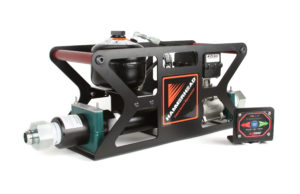 “The R200 allows you to use a small drill on jobs you couldn’t before. If you needed to drill through solid rock, you’d have to bring a large drill to supply enough power which requires more labor, more support equipment, and more time to complete the job. With the R200, contractors can save money by maximizing the capabilities of a small drill,” explained Josh Hood, HammerHead HDD product manager. “When you’re working in small spaces or drilling short distances such as under a road bed, it makes sense to use a small drill and now you can, regardless of soil conditions.”
“The R200 allows you to use a small drill on jobs you couldn’t before. If you needed to drill through solid rock, you’d have to bring a large drill to supply enough power which requires more labor, more support equipment, and more time to complete the job. With the R200, contractors can save money by maximizing the capabilities of a small drill,” explained Josh Hood, HammerHead HDD product manager. “When you’re working in small spaces or drilling short distances such as under a road bed, it makes sense to use a small drill and now you can, regardless of soil conditions.”
A key feature unique to the R200 rock hammer is the electronically-controlled air flow. With the touch of a button, the operator can adjust the air flow from open to closed and anywhere in between which allows them to manage the power of the hammer on the fly. This feature is critical in situations where soil conditions change abruptly. The ability to reduce or increase power quickly prevents costly interruptions during the bore.
The HammerHead R200 air hammer shares similar features with the other models of the HammerHead Roughneck line. The Roughneck R400, R500 and R600 are recognized as some of the most trusted and productive pneumatic rock hammers available for HDD applications. All four models are capable of drilling at rates of up to 150-feet per hour with exceptional steering performance. Additionally, all Roughneck rock hammers feature side-load high-flow housing, a patented pull back kit system and a lightweight control station.
Serviceability is a key design feature in all HammerHead pneumatic hammers and the R200 is no exception. Patented spanner wrench holes in the front and rear of the hammer reduces the number of breakout jaws required when performing maintenance or changing out rock bits.
The HammerHead R200 rock hammer is offered as a complete system to get contractors up and running. The system includes a R200 Roughneck air hammer, offset and angled offset bits, patented pullback kit, control station/oiler with tethered electronic remote control, hydraulic breakout tooling, 2.5-inch universal high-flow housing, and a conversion kit specific to the drill.
The R200 rock hammer system is available from HammerHead Trenchless Equipment or from authorized dealers, worldwide. Authorized dealers can be found on the web at www.hammerheadtrenchless.com or by calling 800.331.6653. (International: + [1] 920.648.4848).
Blog, Industry News, trenchless projects
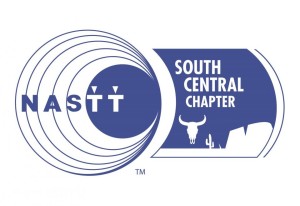 NASTT’s South Central Regional Chapter is hosting their second event on June 20!
NASTT’s South Central Regional Chapter is hosting their second event on June 20!
If you’re in the South Central region, plan to attend the Trenchless Technology and Pipe Conference for Water, Sewer, Oil, and Gas Applications: TTP 2017, sponsored by South Central Chapter of NASTT.
Abstracts for presentations are currently being accepted for the event.
The abstract submission deadline is May 1 and final presentation submission deadline is May 31.
Abstract information (paper is not required):
Abstracts should be submitted in the following format:
- The abstract should not be more than 500 words.
- Please type all text in 12 point Times New Roman.
- Name of the Author/s should be included, with the presenting author’s name underlined.
- Please include the full contact details of the presenting and corresponding author(s) (Address, Phone, Fax, and Email).
Abstracts should be submitted by email, as an attached document, in MS Word format (.doc or .docx) to CUIRE at cuire@uta.edu. Abstract should be submitted by May 1, 2017.
Get all the abstract details on the conference website here.
Be a part of this growing chapter’s history and network with your industry peers!
Blog, Industry News, trenchless people, trenchless products, trenchless projects
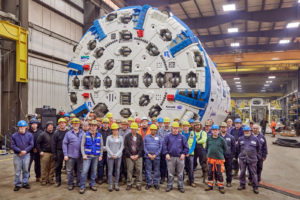 Specialized TBM will work below the Hudson River on the Delaware Aqueduct
Specialized TBM will work below the Hudson River on the Delaware Aqueduct
Robbins has completed the manufacture and testing of a unique tunnel boring machine that will be used to repair the longest continuous tunnel in the world. The TBM will be used to overhaul a section of New York City’s Delaware Aqueduct, a 137 km (85 mi) long tunnel that delivers about 50 percent of the City’s drinking water each day. Over the span of two days in February, representatives from the owner New York Department of Environmental Protection (NYDEP), consultant McMillen Jacobs (MJ), and JV contractor Kiewit-Shea Constructors (KSC) traveled to the Robbins facility in Solon, Ohio to witness the Factory Acceptance Testing of the custom tunnel boring machine.
The Robbins Single Shield TBM will bore a tunnel to replace a 3.8 km (2.4 mi) stretch of the Delaware Aqueduct. The Delaware Aqueduct currently leaks about 75 million liters (20 million gallons) of water per day into the Hudson River. Investigations of the Delaware Aqueduct dating back more than a decade revealed cracks in the tunnel lining. While several inspections with an automated underwater vehicle showed that these cracks were stable, it was determined they could not be fixed from within the existing tunnel. New York City then decided that a new tunnel would be built under the river to bypass the leakage.
To build a bypass tunnel around the aqueduct’s leaking section, Robbins manufactured the 6.8 m (21.6 ft) diameter Single Shield TBM to safely seal against pressures up to 30 bar, and to operate in variable hard rock conditions. The Delaware Aqueduct was completed in 1944. During its original construction, work crews documented groundwater inflows of 7.5 to 15 million liters (2 to 4 million gallons) per day. Because this particular section of the tunnel lies 183 m (600 ft) below the Hudson River, the inflows are under immense head pressure and thus require the unique tunneling technology.
Due to the challenges presented by the Aqueduct Repair, such as difficult geology and considerable water inflows, the TBM had to be designed accordingly. Difficult Ground Solutions (DGS) features, including powerful drilling, grouting, and water inflow control systems have been incorporated into the machine’s design to overcome the expected challenges. “One unique feature of this TBM is the closeable bulkhead, which allows the excavation chamber to be sealed off,” said KSC Tunnel Manager Niels Kofoed. “We expect this to be a key feature in the event that groundwater flows (shunt flows) from the excavated portion of the tunnel cause washout of the annulus grout. Once the bulkhead is closed the groundwater flows are stopped and secondary grouting of the precast liner can be performed, effectively cutting off the flow path of the shunt flows.”
Robbins Project Manager Martino Scialpi further noted that, “the TBM was designed with a 9,500 liter/min (2,500 gallon/min) dewatering capacity. The machine is equipped with two drills in the shields for drilling through the head in 16 different positions and a third drill on the erector to drill through the shields in an additional 14 positions. Drilling and pre-excavation grouting will be a routine job to control and minimize water inflows.” In addition, water-powered, high pressure down-the-hole-hammers will allow for drilling 60 to 100 m (200 to 330 ft) ahead of the machine at pressures up to 20 bar if necessary.
In order to provide access to launch and retrieve tunneling equipment, two deep shafts were constructed in the towns of Newburgh and Wappinger, New York, where the bypass will begin and end. The project site itself poses challenges to the assembly and launch of the TBM because of the limited space available.
Robbins worked closely with KSC to ensure that TBM components were designed and sized so all could be lifted with the contractor’s hoist system and fit down the narrow, 270 m (885 ft) deep shaft. Once assembled, the machine is expected to begin boring in autumn 2017.
Image: The Robbins crew, contractor KSC, and project officials stand proudly in front of the Robbins Single Shield TBM that will tackle hard rock and high water inflows in New York State.
Blog, Industry News, trenchless projects
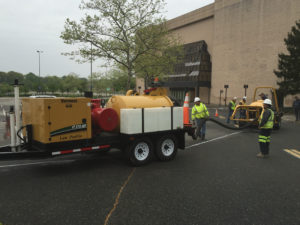
OKAHUMPKA, Fla., February 24th, 2016 – Micro Trenching is one of the installation methods being utilized by contractors to bring fiber networks to consumers. Micro Trenching is an installation method in which a narrow and relatively shallow trench is cut, usually on an asphalt roadway. Trench dimensions can range from .75 to 2.24 inches wide and 8 to 16 inches deep. While cutting, a vacuum system connected to the cutter wheel cleanly diverts and transports debris away from the worksite. Once the conduit is laid, the trench is backfilled with a grout compound.
Advantages of Micro Trenching include minimal cutting width that boosts installation production, reduce costs of backfill, shallow depth placement which helps avoid encounters with existing utilities and jobsite cleanliness thanks to the vacuum spoil that removes debris.
Vac-Tron Equipment has gone one step further in the cleanup process by developing a solution to micro trenching using a specialized in-tank filter (patent pending) inside the vacuum excavation unit’s debris tank. In most cases, the in-tank filter eliminates the need to add water to the micro trenching process and eliminates excessive material from reaching the cyclone separator. By using this filter, it will reduce the cleanup time during the trench run because there will be no need to stop and cleanout the cyclone or unclog the exit hose from debris tank due to caked material. Ultimately this will increase overall efficiency onsite.
David Donohue of Vermeer Mid Atlantic says “The Vac-Tron LP 573 SGT is the ideal vacuum for micro trenching, the high cfm’s and low noise output made communication and productivity simple.” David and Pfeiffer Enterprise Inc were demonstrating Vermeer’s micro trenching equipment and Vac-Tron’s LP SGT high cfm unit in Glen Bernie, MD in this photo.
For more info visit www.vactron.com or call Vac-Tron at 1-352-728-2222.
 In April 2017, a ceremony was held to celebrate the commissioning of the Dariali Hydropower Project in the Republic of Georgia. Many attended the ceremony marking the first carbon-neutral hydropower project in the world, including Georgian Prime Minister, Giorgi Kvirikashvili. The power station, an independent power project (IPP) developed through Dariali Energy Ltd, was a joint venture involving three other firms: Georgian private companies Peri Ltd and Energy LLC, and state-owned Georgian Energy Development Fund (GEDF). The Dariali HPP gathers water from the Tergi River and directs it through the headrace tunnel to the power house located near the Russian—Georgian border. Each year, the site will generate 500 GWhs of carbon-neutral energy, with 70 percent of power production occurring during the country’s summer months.
In April 2017, a ceremony was held to celebrate the commissioning of the Dariali Hydropower Project in the Republic of Georgia. Many attended the ceremony marking the first carbon-neutral hydropower project in the world, including Georgian Prime Minister, Giorgi Kvirikashvili. The power station, an independent power project (IPP) developed through Dariali Energy Ltd, was a joint venture involving three other firms: Georgian private companies Peri Ltd and Energy LLC, and state-owned Georgian Energy Development Fund (GEDF). The Dariali HPP gathers water from the Tergi River and directs it through the headrace tunnel to the power house located near the Russian—Georgian border. Each year, the site will generate 500 GWhs of carbon-neutral energy, with 70 percent of power production occurring during the country’s summer months. Due to the remote and mountainous location of the jobsite 160 km (100 mi) from the capital Tbilisi, the machine was shipped in pieces to contractor Peri’s workshop, where they were refurbished under Robbins supervision and then delivered to the site to be assembled. Each piece was transported by truck down narrow, winding roads that eventually gave way to dirt paths. Assembly at the jobsite was difficult, as the project site at a 1,700 m (1.0 mi) altitude was blanketed in snow and components arrived in December. Bone-chilling temperatures often reached negative 15 degrees Celsius (5ºF), and 40 below with the wind chill factor. Once the machine had launched, it encountered difficult ground including slate, sandstone, limestone and malms with fault zones.
Due to the remote and mountainous location of the jobsite 160 km (100 mi) from the capital Tbilisi, the machine was shipped in pieces to contractor Peri’s workshop, where they were refurbished under Robbins supervision and then delivered to the site to be assembled. Each piece was transported by truck down narrow, winding roads that eventually gave way to dirt paths. Assembly at the jobsite was difficult, as the project site at a 1,700 m (1.0 mi) altitude was blanketed in snow and components arrived in December. Bone-chilling temperatures often reached negative 15 degrees Celsius (5ºF), and 40 below with the wind chill factor. Once the machine had launched, it encountered difficult ground including slate, sandstone, limestone and malms with fault zones. Overall, said Home, there is much to celebrate as the project has immense benefits: “Not only does it provide affordable electrical power for the country with essentially no pollution effects, but it also provided jobs during construction and will continue providing jobs during its operation and maintenance.”
Overall, said Home, there is much to celebrate as the project has immense benefits: “Not only does it provide affordable electrical power for the country with essentially no pollution effects, but it also provided jobs during construction and will continue providing jobs during its operation and maintenance.”








